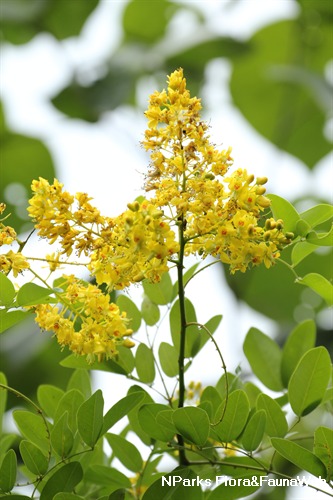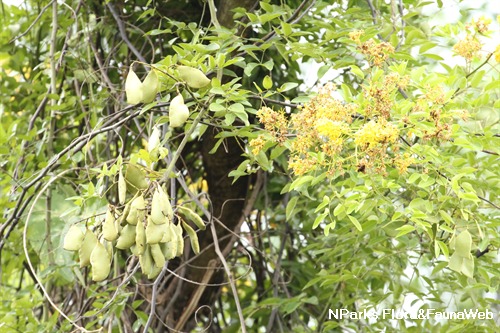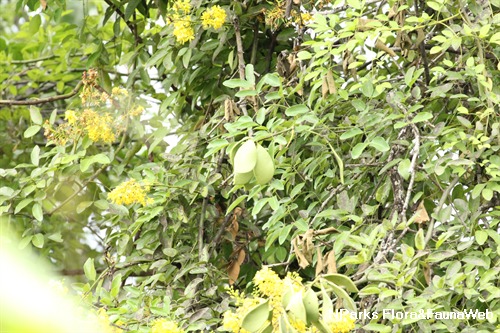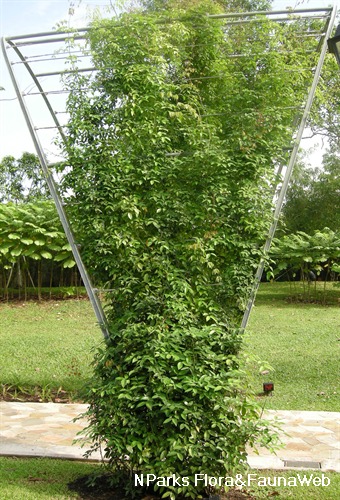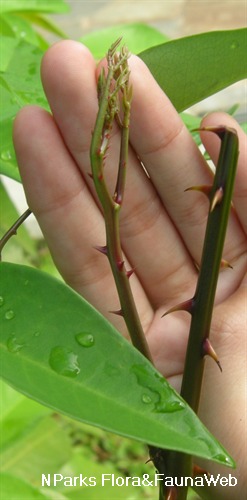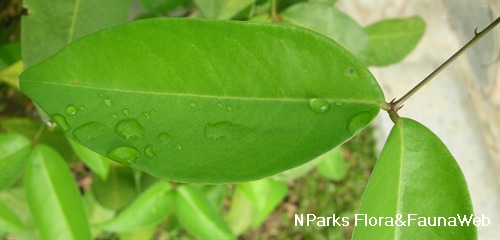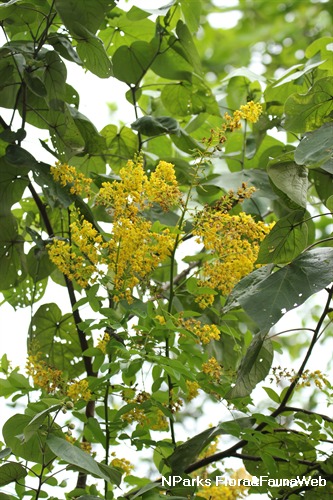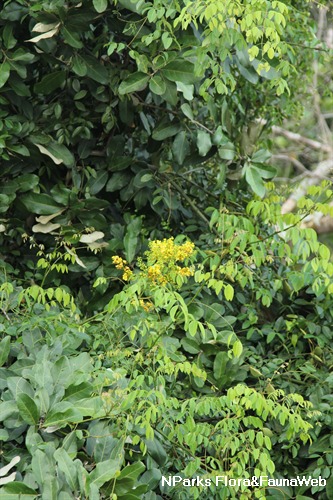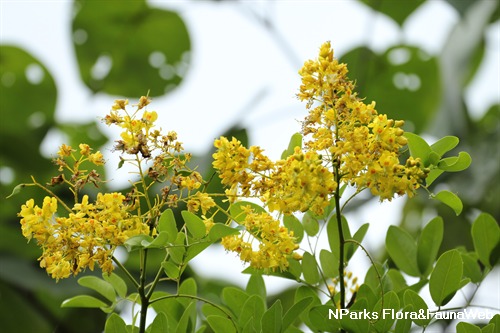
Back
Ticanto crista (L.) R.Clark & Gagnon
| Family Name: | Fabaceae (Leguminosae) |
| Synonyms: | Caesalpinia crista L., Caesalpinia chinensis Roxb., Caesalpinia scandens Roth, Caesalpinia nuga (L.)Ait. |
| Common Name: | Squirrel's Claws, Kuku Tupai, 华南云实 |
Name
Classifications and Characteristics
| Plant Division | Angiosperms (Flowering Seed Plants) (Dicotyledon) |
|---|---|
| Plant Growth Form | Climber |
| Lifespan (in Singapore) | Perennial |
| Mode of Nutrition | Autotrophic |
| Plant Shape | Irregular |
| Maximum Height | 5 m to 20 m |
Biogeography
| Native Distribution | China, Sri Lanka, India, Cambodia, Myanmar, Vietnam, Thailand, Peninsular Malaysia, Singapore, Indonesia, the Philippines, Papua New Guinea, Japan, and Australia |
|---|---|
| Native Habitat | Terrestrial (Riverine), Shoreline (Mangrove Forest, Sandy Beach) |
| Preferred Climate Zone | Tropical, Sub-Tropical / Monsoonal |
| Local Conservation Status | Native to Singapore (Least Concern (LC)) |
Description and Ethnobotany
| Growth Form | A climber with a scrambling growth form up to 5 to 20m in height and can scramble over tall trees. |
|---|---|
| Foliage | Its spirally arranged, stalked, bipinnate leaves have about 2–4 pairs of primary leaflets (pinnae) that are up to 8 cm long and each has 1–5 pairs of opposite secondary leaflets (pinnules). Its leathery pinnule blades are egg-shaped to lance-shaped, shining green above, and 2–10 by 1–5 cm. There are blackish recurved spines along the leaf parts. |
| Stems | The stems are long and covered with short, sharp and curved spines. The young stems are red and turn green as they mature. |
| Flowers | Its flowers grow on terminal and axillary flowering shoots that are 10–20 cm long. The flowers are yellow, fragrant, with egg-shaped petals, and 1.2 cm wide. |
| Fruit | Its pods are leathery, round, egg-shaped to kidney-shaped, swollen, with a beaked tip, and 3–4 by 2–3 cm. Each fruit contains a single seed that is black, compressed, and 12 by 20 mm. |
| Habitat | It grows on riverbanks, sandy beaches, and the sandy parts of mangrove, on chalks and limestones, at low altitude, up to 350 m. It occurs locally in the vicinity of Kranji Reservoir and Pulau Tekong. |
| Associated Fauna | It is the preferred local food plant for caterpillars of the butterfly three-spot grass yellow (Eurema blanda), and the moth Lacera alope. |
| Cultivation | It can be propagated by seed. |
| Etymology | Specific epithet comes from the Greek word crista which means with a small crest, the reference to which is unknown. |
| Ethnobotanical Uses | Medicinal: Its seeds are ground in water and the liquid drunk for colic. The leaves are prescribed for sharp gouty pains in hands and feet. A decoction of crushed seeds is used as an emetic and credited with anti-dysenteric properties. Its fruits are externally applied in the treatment of rash. Its roots are used in the treatment of kidney stones. |
Landscaping Features
| Landscaping | It is suitable for growing in parks over trellises for its ornamental, fragrant flowers. However, it should be noted that there are prickles and spines on this plant. |
|---|---|
| Desirable Plant Features | Ornamental Flowers, Fragrant (Flowers) |
| Landscape Uses | Parks & Gardens, Coastal, Trellis / Arbour / Pergola |
| Thematic Landscaping | Golden Garden, Naturalistic Garden |
| Usage Hazard - Cons | Spines/Thorns - Stem/Branch, Spines/Thorns - Leaf |
Fauna, Pollination and Dispersal
| Fauna Pollination Dispersal Associated Fauna | Butterfly Host Plant |
|---|---|
| Pollination Method(s) | Biotic (Fauna) |
| Seed or Spore Dispersal | Abiotic |
Plant Care and Propagation
| Light Preference | Full Sun |
|---|---|
| Water Preference | Lots of Water, Moderate Water |
| Plant Growth Rate | Moderate |
| Rootzone Tolerance | Moist Soils, Waterlogged Soils (Drains Site), Well-Drained Soils, Saline Soils / Salt Spray, Fertile Loamy Soils |
| Propagation Method | Seed |
Foliar
| Foliage Retention | Evergreen |
|---|---|
| Mature Foliage Colour(s) | Green |
| Mature Foliage Texture(s) | Glossy / Shiny, Leathery |
| Foliar Type | Compound (Bipinnate) |
| Foliar Arrangement Along Stem | Alternate, Spiral |
| Foliar Attachment to Stem | Petiolate |
| Foliar Shape(s) | Non-Palm Foliage (Lanceolate, Elliptical) |
| Foliar Venation | Pinnate / Net |
| Foliar Margin | Entire |
Non - Foliar and Storage
| Stem Type & Modification | Thorn / Prickle |
|---|
Floral (Angiosperm)
| Flower & Plant Sexuality | Bisexual Flowers |
| Flower Colour(s) | Orange, Yellow / Golden |
|---|---|
| Flower Grouping | Cluster / Inflorescence |
| Flower Location | Axillary |
| Inflorescence Type | Panicle |
Fruit, Seed and Spore
| Mature Fruit Colour(s) | Brown |
|---|---|
| Mature Fruit Texture(s) | Smooth |
| Fruit Classification | Simple Fruit |
| Fruit Type | |
| Mature Seed Colour(s) | Black |
Image Repository
Others
| Master ID | 31334 |
|---|---|
| Species ID | 5731 |
| Flora Disclaimer | The information in this website has been compiled from reliable sources, such as reference works on medicinal plants. It is not a substitute for medical advice or treatment and NParks does not purport to provide any medical advice. Readers should always consult his/her physician before using or consuming a plant for medicinal purposes. |

